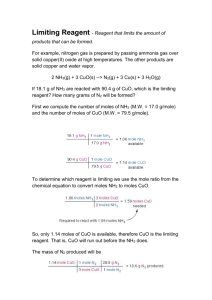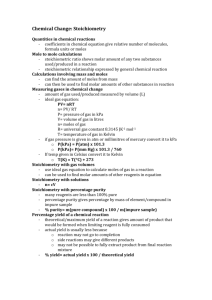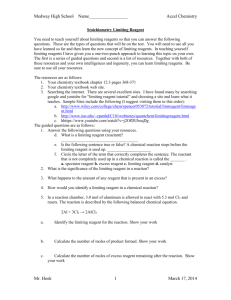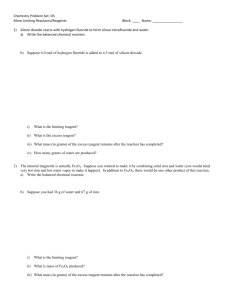111_Experiment_4_Text
advertisement
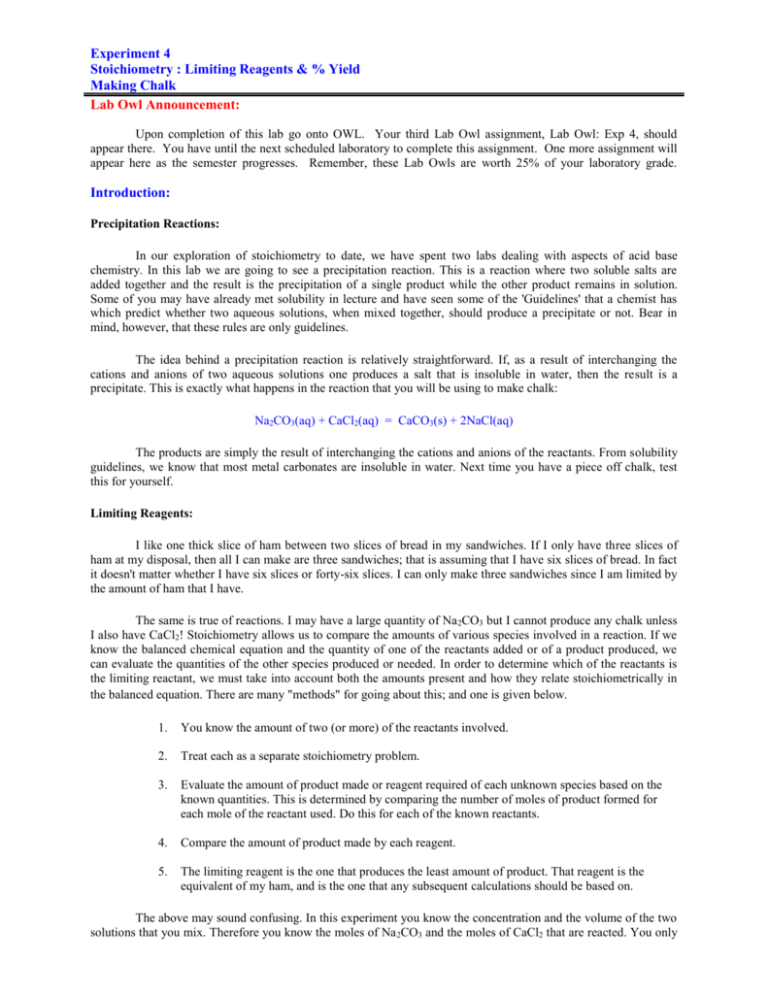
Experiment 4 Stoichiometry : Limiting Reagents & % Yield Making Chalk Lab Owl Announcement: Upon completion of this lab go onto OWL. Your third Lab Owl assignment, Lab Owl: Exp 4, should appear there. You have until the next scheduled laboratory to complete this assignment. One more assignment will appear here as the semester progresses. Remember, these Lab Owls are worth 25% of your laboratory grade. Introduction: Precipitation Reactions: In our exploration of stoichiometry to date, we have spent two labs dealing with aspects of acid base chemistry. In this lab we are going to see a precipitation reaction. This is a reaction where two soluble salts are added together and the result is the precipitation of a single product while the other product remains in solution. Some of you may have already met solubility in lecture and have seen some of the 'Guidelines' that a chemist has which predict whether two aqueous solutions, when mixed together, should produce a precipitate or not. Bear in mind, however, that these rules are only guidelines. The idea behind a precipitation reaction is relatively straightforward. If, as a result of interchanging the cations and anions of two aqueous solutions one produces a salt that is insoluble in water, then the result is a precipitate. This is exactly what happens in the reaction that you will be using to make chalk: Na2CO3(aq) + CaCl2(aq) = CaCO3(s) + 2NaCl(aq) The products are simply the result of interchanging the cations and anions of the reactants. From solubility guidelines, we know that most metal carbonates are insoluble in water. Next time you have a piece off chalk, test this for yourself. Limiting Reagents: I like one thick slice of ham between two slices of bread in my sandwiches. If I only have three slices of ham at my disposal, then all I can make are three sandwiches; that is assuming that I have six slices of bread. In fact it doesn't matter whether I have six slices or forty-six slices. I can only make three sandwiches since I am limited by the amount of ham that I have. The same is true of reactions. I may have a large quantity of Na 2CO3 but I cannot produce any chalk unless I also have CaCl2! Stoichiometry allows us to compare the amounts of various species involved in a reaction. If we know the balanced chemical equation and the quantity of one of the reactants added or of a product produced, we can evaluate the quantities of the other species produced or needed. In order to determine which of the reactants is the limiting reactant, we must take into account both the amounts present and how they relate stoichiometrically in the balanced equation. There are many "methods" for going about this; and one is given below. 1. You know the amount of two (or more) of the reactants involved. 2. Treat each as a separate stoichiometry problem. 3. Evaluate the amount of product made or reagent required of each unknown species based on the known quantities. This is determined by comparing the number of moles of product formed for each mole of the reactant used. Do this for each of the known reactants. 4. Compare the amount of product made by each reagent. 5. The limiting reagent is the one that produces the least amount of product. That reagent is the equivalent of my ham, and is the one that any subsequent calculations should be based on. The above may sound confusing. In this experiment you know the concentration and the volume of the two solutions that you mix. Therefore you know the moles of Na 2CO3 and the moles of CaCl2 that are reacted. You only need one to predict the amount of CaCO3 that could be produced. Go ahead and evaluate that for each reagent independently. If both give the same amount then neither is a limiting reagent. If on the other hand there is a discrepancy, then the reagent that gives the smaller amount is the limiting one. That's what you are about to prove to yourself in this experiment. Ah but why? Why in the first place have more of one reagent than the other. If you produce no more product, then it just does not make economic sense to use an excess of one reagent. The complete answer to this lies a little into next semester for you! As a small prelude: not all reactions go 100% to completion. In fact the majority of really interesting ones do not. However one trick employed to make them go nearer to completion is to start with an excess of one of the reactants. This essentially makes the other the limiting reagents. Getting back to economics, it makes sense to choose the less expensive reagent as one to use in excess. A more in-depth explanation awaits you in Chem 112. Percent Yield…..Efficiency: This always seems to lead to some confusion. Even with a reaction that is expected to go to completion, it is altogether another matter when you then go into the lab and perform it. Preparations often require a variety of manipulations and transfers that lend themselves to loss of product. Some of these losses are due to human error that can be eliminated with experience and improved technique. However, more often it is due to the actual procedure involved. Percent (%) Yield is a measure of the efficiency of the experimental design: % Yield (Efficiency) = (Mass of product obtained/Calculated mass of the product expected)x100 In this reaction a % yield >80 is anticipated. Experimental Procedure Making Chalk. Reaction ~0.5M CaCl2 ~1.5M Na2CO3 #1 20 mL 10 mL #2 25 mL 5 mL . 1. Set up two steam baths using 400mL beakers. 2. Fill a buret with the ~0.5M CaCl2 solution provided. Label the buret (Both solutions look identical!), and record the exact molarity. Record the initial buret reading and dispense as close as you can to the required volume of CaCl2 into a clean Erlenmeyer flask. While it would be nice to get as close as possible to the recommended volume, it doesn't have to be exact, so long as you record the final buret reading. (Remember it is a buret that you are using and hence all volumes should be recorded to two decimal places) 3. Fill a second buret with the ~1.5M Na2CO3. Label it!, and record the exact molarity. Use the same procedure as 2 above to dispense as close as possible to the recommended amount of Na 2CO3 into the Erlenmeyer that contains the CaCl2. 4. Initially you may not observe a precipitate. Swirl the flask and one should quickly form. 5. Vacuum filter the white solid. Your TA will demonstrate how to set this up. 6. Carefully remove the filter paper (it will still be very moist) and place it on a pre-weighed watch glass. Place this on the steam bath and leave it there until the paper has dried (~10 minutes) Note: This is a good time to start the procedure over for the next reaction. 7. While the product is drying, determine the #moles of CaCl 2 and Na2CO3 that were added together. For each calculate the #moles of CaCO3 that would be expected. Was there a limiting reagent? If so which one was it? 8. When the paper is dry remove the watch glass from the water bath. Allow it to cool to the touch and very carefully using a glass rod; scrape the CaCO3 from the filter paper onto the watch glass. Try and get as much as you can off without tearing or scarping off some of the filter paper. Discard the filter paper and return the watch glass to the steam bath for a further ten minutes. 9. Remove from steam bath and allow it to cool to room temperature. Dry off the watch glass. This is critical (6 drops of water ~1ml which weighs 1g!). Record the weight of the watch glass and CaCO 3. Then reheat on the water bath for a further 5 minutes. Repeat this process until you get two weighings that are within 0.02g of one another. If you follow the procedure closely, two heating’s should be sufficient. 10. Compare the amount of CaCO3 obtained with that expected. Determine the % efficiency of this reaction. Useful Molar Masses: CaCl2: 110.98 g.mol-1 Na2CO3: 105.99 g.mol-1 CaCO3: 100.09 g.mol-1

